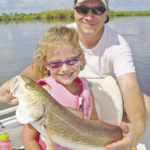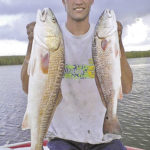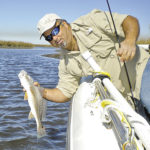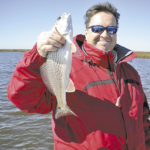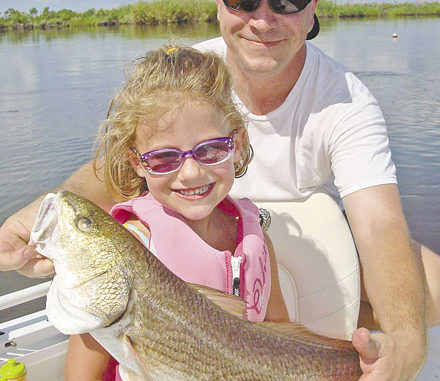
Delacroix’s other fish is always available this month.
“The solution to any problem — work, love, money, whatever — is to go fishing, and the worse the problem, the longer the trip should be.”
—John GierachLet’s admit it: March is a problem for inshore anglers. It’s a challenging month for both inshore and offshore fishermen because of the horrible winds and the resulting dirty water.
If you’re a diehard trout chaser, you generally don’t find a whole lot to get excited about this month. Trout tend to be scarce. It’s usually wayyy too windy for venturing offshore. Hunting season is over. Football season is over. Freshwater fishing is unappealing to those of us with saltwater in our veins, and golf? Well, even Sam Snead said the only reason he ever played golf was to make enough money to hunt and fish.
So the only option open to many of us this month is to fish for reds, which is actually a very attractive solution to our no-trout problem. Reds are hard-fighters, abundant in our coastal waters, voracious predators and ready to pummel your baits in March. You generally don’t have to run very far to find them this month either, because they’re still hanging in the ponds and lagoons throughout the marsh, foraging for bait.
Since trout tend to be so elusive this month, I challenged Capt. Casey Kieff (504-512-7171), who grew up on the waters of lower St. Bernard, to put us on some redfish.
Normally, finding reds in the Delacroix marsh isn’t that much of a challenge, especially for someone of Kieff’s heritage. A third generation fisherman, Kieff dredged oysters and trawled for shrimp for 24 years before he began guiding in 1989. For about a dozen years, he mostly guided trips to the Chandeleur Island chain, fishing for trout, reds and just about every other saltwater species that prowls the area.
A lifelong fisherman shouldn’t have too much trouble finding redfish in the marsh, right? But the challenge was in the conditions. The water was low — I’m talking dead-of-winter low. Three feet of mud bank stuck out on both sides of every waterway. This is the kind of low water that changes my mind about fishing that day. I see visions of being stuck in the mud, and spending a frigid night in the marsh waiting for the tide to rise.
Top off the low water with howling winds from the northwest, and did I mention that it was cold? I find as I grow older that I have less tolerance of the cold, and the idea of running the marsh in a boat in frigid weather isn’t something to which I look forward.
I kept putting off a trip hoping for warmer weather, but when nothing warmer was on the horizon, I reluctantly agreed to a venture. We also agreed to a later start than usual to give the water and the fish a chance to warm up.
So we met at the dock. My brother-in-law, Sterling Cardon and I loaded our gear aboard, and Kieff pointed the bow toward the marsh.
We made a relatively short, bone-chilling ride, and kicked up mud in several places along the way. The main bayous generally have deep enough water even in such conditions, but many other canals and pipelines, including the Twin Pipelines, are deceptively shallow in places.
Kieff likes to fish the Lake John area for reds this time of year. He cut the outboard to idle, and then switched it off altogether as we neared a shallow shoreline.
“Some of the places I like to fish in March we just won’t be able to get to today because of the low water,” he said. “Usually there’s 3 to 4 feet of water in here, but not today. So we’ll improvise and fish where we can.”
Kieff’s picks
• The northwest side of Lake John.
“The whole shoreline is a great place to troll,” he said. “Stay out far enough to make a cast to the bank, and toss Gulps, gold spoons, spinnerbaits (beetle-spins with a black/chartreuse beetle), soft plastics in purple/white or purple/chartreuse or market shrimp under a cork. Make your plastic bait more enticing by tipping it with a piece of shrimp.”
Kieff says if you catch a fish or get a good hit, stick your Cajun anchor or Power Pole down, and try to work the area thoroughly.
“Where there’s one, there’s usually two or more,” he said. “Sometimes you can sit in one place and catch five or six, or even limit out. Or you might catch one lonely straggler. If you don’t catch another fish in 10 minutes, pull up the pole and resume trolling.
“The key is to try to find some decent water, and that can be a challenge in itself right now. Not only is the wind kicking up the bottom and dirtying things up, but the river is high, and that spills over to the Delacroix side through the (Caernarvon) Diversion. Muddy river water could chase the fish farther out or over toward the Hopedale and Shell Beach side, depending on how high the river gets during the spring thaw.
“They had a long and cold, snowy winter up north. When all that snow begins to melt and come downriver, it could spell trouble for us down here.”
• The ponds above Lake John.
Kieff says there are numerous meandering ponds just above Lake John that hold redfish.
“This is another great area to troll and beat the banks with those same baits,” he said. “Follow the same pattern, and try to focus on points, drains and cuts. Look for clean water with some decent current, and keep moving until you bump into some action.
“It’s still a bit early for trout in there, but I wouldn’t be surprised if you picked up a couple specks in the process.”
• Four Horse Lake.
Kieff likes to drift and troll the northwest shoreline of Four Horse Lake, casting the same baits and following the same basic technique.
“Try the mouths of the bayous at Four Horse for trout,” he advised. “Try tightlining plastics on a ¼-ounce jig, and try fishing them under a cork. Like I said, it’s a bit early for the specks to show up, but you can sometimes bump into them right there.”
I started the morning fishing with plastic, and after a while with no success, I switched to a spoon. Meanwhile Kieff was fishing with a chunk of market shrimp on a hook under a cork, and getting consistent hits from both redfish and drum. Cardon was fishing soft plastic tipped with shrimp, and also catching reds and drum.
I finally switched to my cork rig, and tipped a purple/chartreuse H&H Cocahoe with shrimp, and almost immediately had a good hit. But when I set the hook, my monofilament line broke. It snapped clean in half, just above the cork.
Considering it a fluke, I retied, and tipped a Billy Bay Halo shrimp with a piece of shrimp, and threw right back to the same spot. I soon had another good hit, and I set the hook on what seemed to be a good-sized redfish when my line snapped again, this time right past the tip of my rod.
That led to a closer examination of my line, and I discovered it was defective. This was brand-new 12-pound-test, just spooled on, but brittle as a dried twig. That has happened to me twice before, once with mono and once with braid. So I was forced to fish the rest of the day with my baitcaster, which doesn’t work out too good with a cork. But a soft plastic cocohoe tipped with shrimp and slowly dragged along the bottom eventually produced some redfish.
Stan’s stops
Surprisingly, Capt. Stan Cuquet says this is one of his favorite months to fish, and he likes to target trout!
“After Mardi Gras, I start heading out toward Oak River, and I fish the natural bayous nearby,” he said. “I don’t fish the pipeline canals. I fish the natural bayous just off of Oak River, anywhere from Bayou LaCroix to the Twin Pipelines, on both sides of Oak River.
“The fish stage in the deeper water of those bayous, in 6 to 8 feet of water, but always near the shallower water of lagoons and ponds.”
Cuquet has been chasing specks in those areas every March for decades, and year after year they show up.
“However, a very high river could change that this year,” he said. “If the area is inundated with muddy river water from the spring melt, the trout will not be in there.”
Rather than pointing out any particular bayou, Cuquet said to try any of the natural bayous within a mile of Oak River on either side.
“Try around Wreck Bay, Bakers Bay, First, Second and Third Bay, Bay Jack Nevette, Skippy Lake, Bayou Dominique — any of those areas,” he said.
Besides clean water, a key to Cuquet’s success in March is his choice of baits.
“I fish hard plastics,” he said. “MirrOlure Catch 5s, Rapalas, Swim’N Images — just about any minnow-imitation, shallow-swimming or suspending hard bait. I troll until I get a hit, and then I stick the pole and see if more are in there. I’ll sit right there and fish as long as I get bites, and I’ll move on when the bite stops.
“The majority of the fish will come near the shallow ponds. They’ll be hunting the minnows that start showing up this time of year, and once the minnows show up, the trout will be there.
“If the weather cooperates and you want to try to find some bigger fish, try the islands in Bay Lafourche. I like to toss the same baits out there at the points of those islands, and often catch some nice trout and redfish around them.
“If you are specifically targeting redfish, I’d suggest the north shoreline of Bakers Bay, or the windy side of Oak River Bay, if it’s not too rough. Green sparkle beetles tipped with shrimp and fished under corks are the ticket. I’d focus on cuts and points, and prefer an incoming tide over a falling tide, although you can catch fish on either one.
“As long as you have current, decent water and cooperative winds, you should be able to find some good fish, even in March.”
Capt. Casey Kieff can be reached at (504) 512-7171. Capt. Stan Cuquet can be reached at (504) 451-7600.
